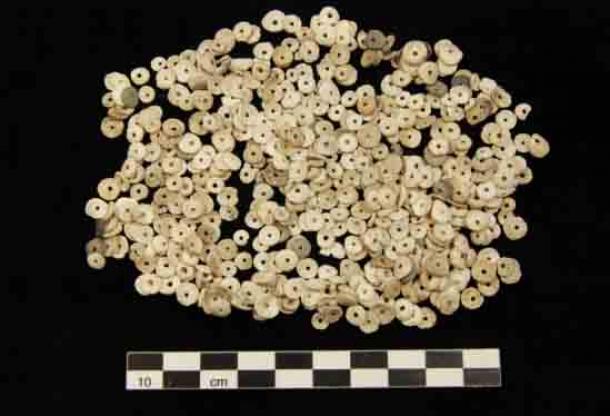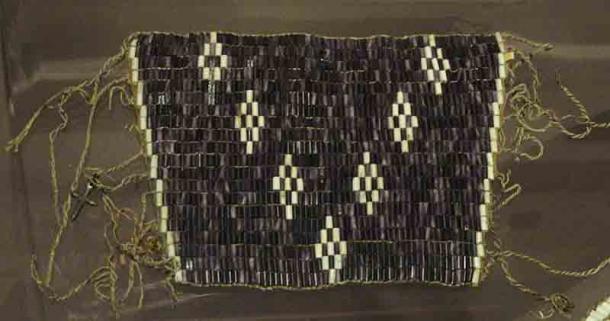A Californian researcher who studied tens of thousands of shells decorated by indigenous Chumash hunter-gatherers, has pushed back the origins of “cash” in the U.S. by over one thousand years.
Dr. Lynn H. Gamble from the Department of Anthropology at the University of California, Santa Barbara, has completed an extensive review of the shell bead record among Chumash Indians living in California. The researcher discovered that the hunter-gatherers of the Southcentral Coast of Santa Barbara were using highly worked shells as currency as far back as 2,000 years ago.
This discovery, according to a report in Science Daily , is perhaps the earliest evidence of currency being used “anywhere in the Americas,” and if so, the finding changes our thinking of hunter-gatherers and “sociopolitical and economic complexity,” said the researcher.

Chumash cupped beads from purple dwarf olive sea snails (Olivella biplicata). ( Credit: Lynn Gamble / SBMNH collection )
Mystery of the Californian Saucers
The researcher’s new paper, ‘The origin and use of shell bead money in California’ was published in the Journal of Anthropological Archaeology . Dr. Gamble wrote that shell beads have been used for over “10,000 years in California” and that shell bead-making drills, and heaps of “detritus” (smashed shells) have been on the northern Channel Islands for around 3,000 to 4,000 years. Until now it has been generally accepted that “all” of these beads were decorative.
Ancient beads that were designed for use as currency, however, were bigger and required more manufacturing work than decorative beads. Furthermore, currency beads are generally more widely distributed. Having analyzed the Californian bead-record, the researcher then compared them to shell beads that had been accepted as a money bead for over 40 years, and also to “saucer beads,” tens of thousands of which have been found in the San Francisco Bay Area. Produced south of Point Conception and probably on the northern [Santa Barbara] Channel Islands , it is known that these earlier “saucer-beads” were traded as currency throughout California and beyond.

A Chumash kit for making shell beads. ( Credit: Santa Barbara Museum of Natural History )
Battle for Currency Control in the New World
Stepping aside from the story for a moment, according to the American Credit Union , while under English rule, early American colonists used English, Spanish, and French currencies until 1775, when the Continental Congress issued a currency to finance the impending Revolutionary War. Paul Revere famously crafted the first plates for this “ Continental Currency ,” which were transferable for “Spanish Milled Dollars.” However, bullion backing for the new currency failed to appear and the Continental Currency was quickly devalued, hence the term: “not worth a Continental.”
The term “dollar” had already been in common usage since the colonial period, referring to the Spanish dollar (eight-real coin) and it was on April 2, 1792, that the United States Congress created the “United States dollar” as the country’s official standard unit of money.
According to Native CC , one of the earliest forms of Native American currency was the “Wampum.” This string of beads sometimes measured six feet (1.83 meters) long and it was used for keeping trading accounts with other Native Americans, as well as colonists. The Wampum was used to barter for furs, tobacco, indigo, rice, wheat, maize, however, the colonists soon imported their own drills and started producing their own wampum, leading to its devaluation and ultimate collapse as a currency.

Wampum wrist ornament, probably Iroquois, 18th century. Exhibit from the Native American Collection, Peabody Museum, Harvard University, Cambridge, Massachusetts, USA. ( CC0)
The Chumash Beads Push Back the Origins of Currency in the U.S.
Being hunter-gatherers, it was for the longest time assumed that the Chumash never needed a system of currency, however, by painstakingly measuring and comparing different Californian bead types the researcher has demonstrated how saucer-beads were “probably used as money beads much earlier than we [Californian archaeologists] previously thought.” The results of this new research project not only resets the origins of money in the Americas, but calls into question “what constitutes sophisticated societies in prehistory?” according to Science Daily .
This new understanding of the Californian Chumash origins of money in the U.S. not only resets the date for the beginnings of the use of money by 1,000 years, possibly across the Americas, but it also provides evidence that money was used by “non-state level societies,” which Dr. Gamble says are commonly identified as “civilizations”. In conclusion, according The Santa Barbara Independent , this new paper presents what might be “the first example of the use of money anywhere in the Americas”.
Top Image: Chumash people carrying a canoe. ( Public Domain ) Shell beads found in the Santa Barbara Channel region as well as elsewhere in California. ( Credit: Tacy Kennedy / Santa Barbara Museum of Natural History )
By Ashley Cowie
Related posts:
Views: 0
 RSS Feed
RSS Feed

















 January 31st, 2021
January 31st, 2021  Awake Goy
Awake Goy 


 Posted in
Posted in  Tags:
Tags: 
















